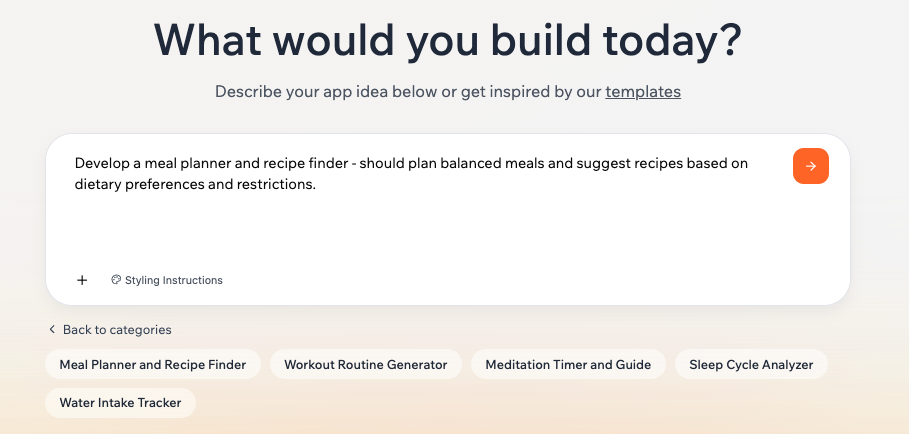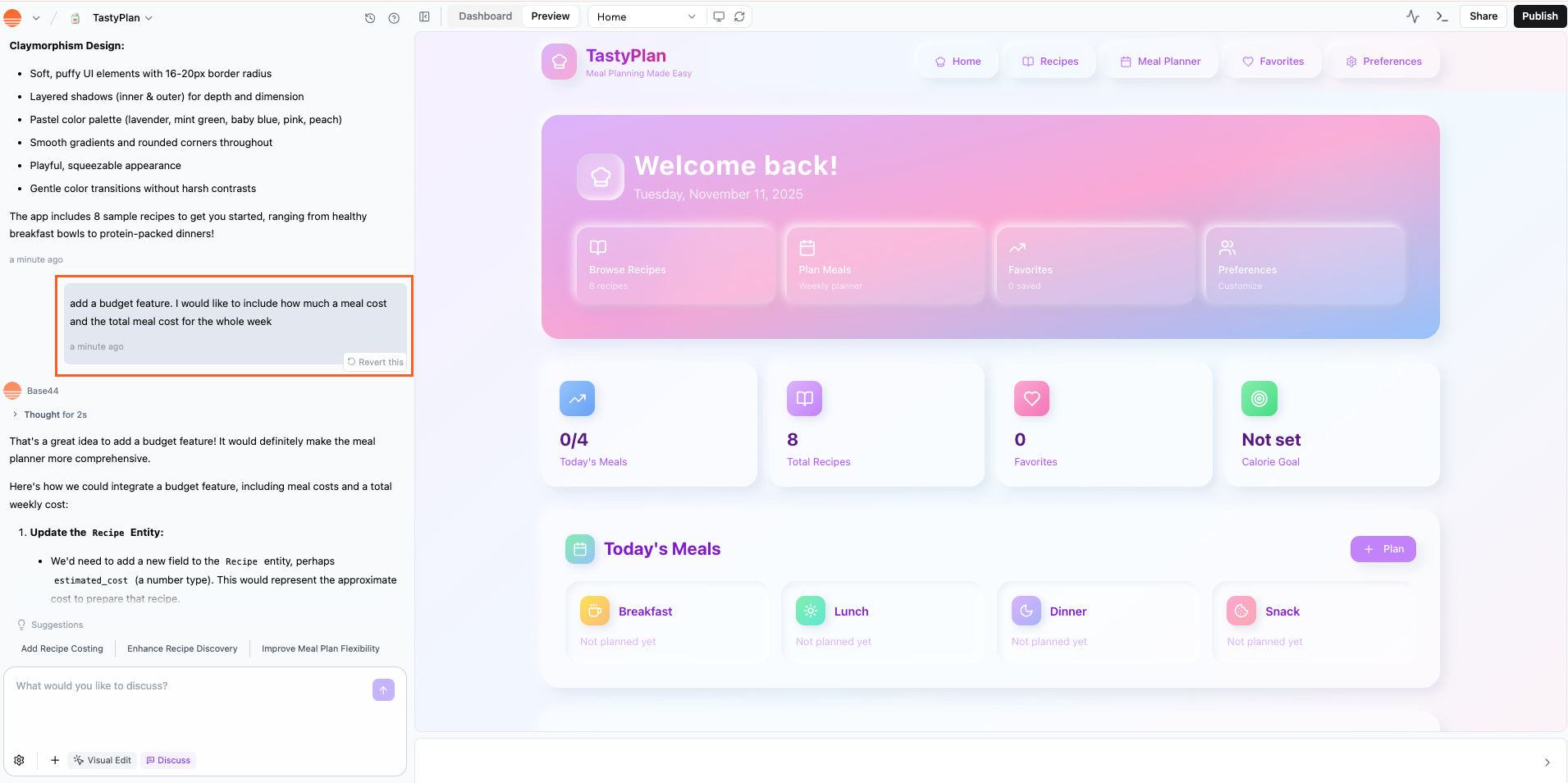Writing your first prompt
Writing your prompt is the very first step to building the app you always wanted. Just type what you want your app to do, and the AI will build it for you. You do not need to be a developer or understand code. This is vibe coding - turning your ideas into real apps simply by describing them in your own words.
Writing your first prompt in Base44
Build a workout generator. It should create personalized workout plans based on my fitness goals, equipment availability, and time availability in my week.
Build a CRM for photographers. Include features for clients’ galleries, photoshoot bookings, and pricing packages.
Ready to get started?
Take me to Base44 to build my app
Chatting with AI
After you send your first prompt, Base44 starts building right away. You can see your app instantly in the preview. But this is only the beginning. Base44 is designed for real conversation, so you can keep chatting, make changes, and shape your app step by step. You can ask questions, add new features, update details, or change your mind at any time. There’s no limit to how many changes you can make. If you want to try a new layout, add a page, or remove something, simply type your new request and the AI will update your app in seconds.
Chatting with the AI to add features after your first prompt
- Discuss mode: Use Discuss mode whenever you want to brainstorm or talk through ideas with the AI before making any changes. It’s a great way to explore options and get feedback without affecting your live app until you’re ready. Learn more about the chat modes
- Revert history: If you change your mind or want to go back, you can easily restore any previous version of your app. Experiment as much as you like, knowing you can always undo or revisit past versions if you need to. Learn more about reverting changes
Tips for great prompts
These 4 simple strategies will help you write prompts that give you the strongest results with Base44.Be clear and specific
The more details you share, the better the results. Say what you want your app to do, who it’s for, and any must-have features. You can decide on additional features later on, but start with the most important ones.You can try the simple Who, What, Why framework. For example:
- WHO: Who is this app for?Independent consultants
- WHAT: What does it help them do? Manage client projects and deadlines in one place
- WHY: Why would someone use it? To save time and stay organized
Think about who will use your app
Picture how you, or someone else will use your app. Describe the main steps or journey your users will take, such as signing up, adding information, or tracking progress. This helps the AI design an experience that feels natural and helpful.For example, you can tell the AI “Users sign up, create a new project, set milestones, and track their progress daily.”
Focus on the outcome, not the process
You do not need to explain any technical steps or describe how things should work behind the scenes.Simply share the end result you want, like “Let teachers upload assignments and send feedback to students.” The AI handles all the complex details for you.
Keep evolving your app
Your first prompt is just the beginning. You can always ask for changes, updates, or new features.For bigger or more complex apps, try building in steps. Start simple, then add features or design details one at a time. Experiment until your app matches your vision. Every time you give feedback, Base44 will keep improving your app.
Techniques for better results
When you’re refining your app, there are some ways you can talk to Base44 that will help it execute on your vision.| Technique | When to Use It | Examples | Pro Tip |
|---|---|---|---|
| “Make it more…” / “Make it less…” | Adjust tone, layout, or emphasis | - “Make the header less bold.” - “Make the CTA more persuasive.” | Add why: “Make the CTA more persuasive because it’s the final step in the user’s journey.” |
| “Add a…” / “Remove the…” | Add/remove specific features or UI blocks | - “Add a comments section to each task.” - “Remove the pricing page for now.” | Group actions for greater efficiency: “Add a comments section and move it below the task list.” |
| “Change [this] to [that]” | Adjust text, visuals, layout, or component logic | - “Change the sidebar color to charcoal.” - “Change the ‘Submit’ button to say ‘Send Request’.” | Layer context: “Change the button text to match the friendly tone used in the rest of the app.” |
| “It should feel like…” | Borrow familiar app styles to guide layout or behavior | - “It should feel like a mix between Duolingo and Habitica.” - “Like a lighter version of Airtable.” | Clarify which parts: “Use Duolingo’s playful tone and Habitica’s gamified progress system.” |
| “Add logic for…”(optional) | Add functional rules or flows without needing code | - “Add logic to hide completed items from the default view.” - “Send a reminder if no action in 3 days.” | Describe the desired outcome once the logic is added: “Add logic so users get nudged if they haven’t logged in for a week.” |
| “Group or organize…” | Structure content for clarity or workflow | - “Group tasks by category” - “Organize settings into collapsible sections” | Mention user needs: “Organize tasks by category so users can quickly find what they need.” |
| “Add conditional behavior…” | Introduce smart branching or state-based functionality | - “Only show the download button after payment is confirmed.” | Start simple, expand later: “Add the condition first, then I’ll add variations per user type.” |
| “Let users…” statements | Frame functionality from the end-user’s perspective | - “Let users upload documents and tag them.” - “Let users bookmark resources for later.” | Frame the functionality around unlocking value for the user: “Let users upload documents and tag them so they can easily find them later.” |
FAQs
Click a question below to learn more about using prompts in the AI chat.Why can’t I implement the feature I want?
Why can’t I implement the feature I want?
Some features might not be supported. If you’re unsure, you can ask in our Discord help channel.
Why does the AI change parts of my app I didn’t mention, and how can I control this?
Why does the AI change parts of my app I didn’t mention, and how can I control this?
You can use the AI Controls to limit the AI’s changes to only the areas you want updated. This is especially helpful if other parts of the app are getting altered intentionally. Learn more about customizing the AI chat
How can I review ideas with the AI before using credits on changes?
How can I review ideas with the AI before using credits on changes?
Use Discuss mode in the bottom of the AI chat. This lets you talk through ideas, review logic, or plan steps with the AI before making changes or using any credits. It’s ideal for making sure your goals are clear and exploring alternatives before applying updates to your app. Learn more about the chat modes
Why isn’t the AI following my instructions correctly?
Why isn’t the AI following my instructions correctly?
It make take the AI a few attempts to get the perfect solution. The intent isn’t always fully clear and small bugs may pop up. To get better results from the chat, it’s really helpful to be as specific as possible about the element you’re referring to.Here are some tips we recommend:
- Using Visual Edits to directly highlight the element and describe the change you want
- Explaining what you do want to happen (rather than what’s wrong)
- If repeating prompts, try rephrasing with keywords like redesign or rebuild
- Writing in your own natural language, the simpler and clearer the request, the more accurate the response will be.
What should I do if AI responses are slow or get stuck?
What should I do if AI responses are slow or get stuck?
If the AI is taking too long or seems stuck, try refreshing the page or resending your prompt. This usually fixes the issue and gets things moving again.
How can I prompt better to avoid losing code changes with AI-generated code?
How can I prompt better to avoid losing code changes with AI-generated code?
When working with AI-generated code, results may not always be as expected. To reduce the risk of losing your changes:
- Use AI controls to add custom instructions or important notes you want the AI to remember for every prompt.
- Repeat any critical details or requirements in your prompts, especially when context matters.
- Save your work regularly and keep backup copies of important versions of your code.
- Remember that effective prompting is a skill. As you gain experience and AI tools improve, your results will get better.
- Carefully review both your prompts and the AI’s output to make sure your context and requirements are handled the way you intend.

